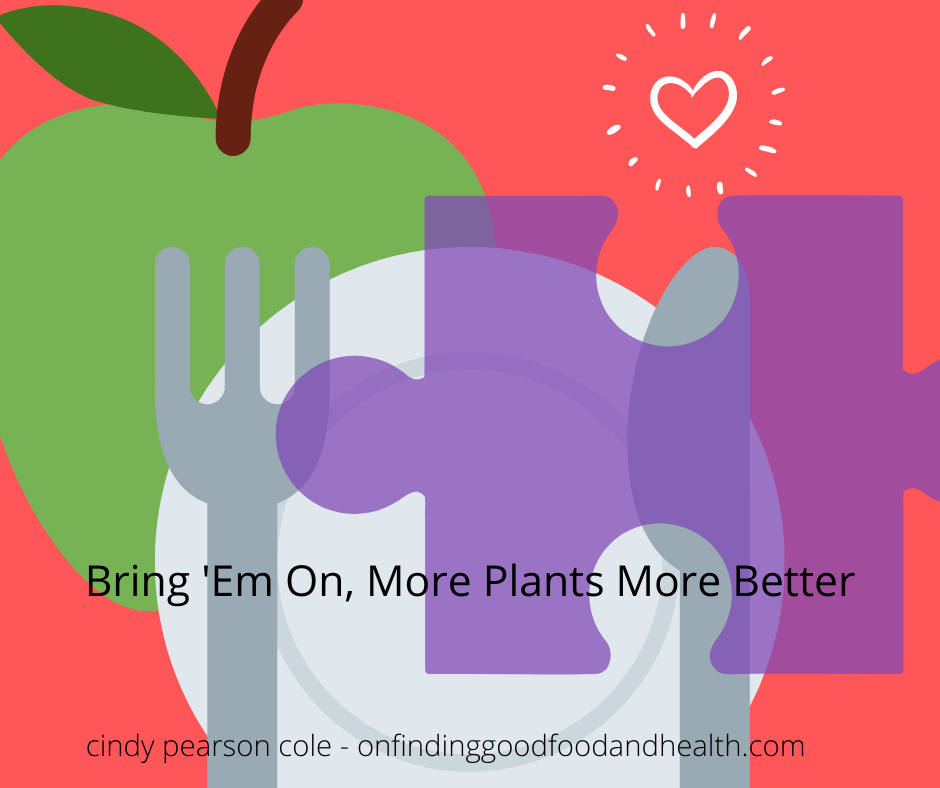
Forking up more plants from your bowl, plate, or dinner trough is a great idea. You’ll get more of those immune-boosting phyto-nutrients and anti-oxidants, more fiber – essential for sweeping your system of excesses and toxins – “fiber is the broom that sweeps the colon clean” the saying goes and will leave you feeling more sated, healthier, and trim.
The more plants the more better! Want to know how?
Go hundred percent all in! Leave Standard American Diet (SAD) food behind. Benefits will be felt quickly, which will reinforce your decision. That’s what we did. It’s also not the only way. So …
Or maybe you’d like to ease in. That works too. Just be sure to beware a few caveats, which I’ve included after the different routes listed below to getting more plant magic coursing its way through your body.
- Add more plants to your all of your existing meals. Pile your plate with your favorite veggies, raw, roasted or steamed, then tossed with lemon or lime, or a tasty oil-free dressing. Add starchy filling foods such as brown rice, potatoes, whole grain pasta. Add fruit to every meal. Pile your plate high with plant foods. Consider trimming the portion size of animal-based food, and eat the animal food last.
- Do plants for snacks. Roast or bake your favorite potatoes, store in fridge, heat and eat as snacks. Better two baked potatoes with salsa then a candy bar. Don’t worry about eating too many. Sweet potato can quench a craving. Then it’s no matter if little ones “ruin” their appetite. Slice apples and oranges. Carrots and chopped cabbage can be eaten out of hand to fill the need for crunch, carrots and celery can be dipped in salsa, oil-free hummus, and, veggie-based cheese sauce. It was an omni friend, actually, who suggested we carry small boiled or roasted potatoes in our bike jerseys when we’re out cycling, and we also carry carrots and bananas. Some other folks I know make rice balls. Lots of options here.
- Prepare your food oil-free. Oil is the most calorie-dense food of any, animal or plant, and is highly processed, offers no health benefits, and is injurious to your arteries and more. If you want an olive, eat the olive instead of its oil! Or chop olive into tiny bit pieces and toss it through your pasta. Now you’ve got olive flavor, fiber, and nutrients. In addition to health protection, lots of people want to drop pounds … cooking with oil (and dunking bread in oil) are not helpful in this regard.
- Find a dressing that you love to toss with your greens and grains. If you’re not used to eating vegetables and grains so often or in greater volume, having a healthy dressing (or squeezes of lemon or lime, or vinegar) can be super helpful in making this transition.
- Find your favorite green, chop it up and serve whatever you’re having on top, or stuffed inside. Toss it with that favorite dressing if you need help getting it down. Give yourself at least a fist full, if not a bed. Eat from the bottom of your plate up, getting a little flavor from your top dish with every bite of greens.
- Swap out some SAD meals for whole-food, plant-based (WFPB) meals. One by one, meal by meal, you pick the pattern and pace. Breakfast is a great starting point: find some WFPB versions that you look forward to such as oatmeal, cinnamon, and fruit. Or rice and beans with lime. It’s handy to have a standard breakfast, and a fancy fare option or two. Around here, tricked-up breakfasts might be a sweet potato-apple-banana parfait, savory oats with greens, pancakes, or a potato-based scramble.
- Eat WFPB at home, do SAD when dining out. This is a viable option, and it was our plan when we started 6 years ago. It’s also problematic, and we ditched it pretty quickly for a few reasons. One, we didn’t feel as good after eating SAD meals out. Heavy, sluggish, brain fog, etc. And after awhile they can taste greasy, and, restaurant food is typically over rich in sugar, oil, and fat which can be addictive (despite the bad after feelings) AND can undo any health gains. Finally, it’s important to let restaurants and folks know that plant-based options are in demand. So, if you’re eating out, press for plant-based options. And ask for oil-free!
3 caveats to remember when transitioning and easing-in to more plant-based food:
1. Health improvements come more quickly and noticeably when you go from SAD to WFPB all in. Dean Ornish, MD frequently says, “little efforts produce little results”. And when results are barely perceptible, it’s easy to say “this diet isn’t do me any good, I’ll just quit.” So be mindful, know yourself, and if it doesn’t work “easing in”, then consider going all in. For me, the improvements that came with going all in were very motivating. For others, easing in can work.
2. Palate change. When you’re accustomed to food made with lot of sugar, fat, and oil, it can take some getting used to when you’re plating up plant food made without that stuff. That palate adaptation can take longer when easing in. So concentrate on finding plant-based food that you like and if you need a little salt or sugar to make the switch, do it. Leave the oil behind when you can. Once your palate has adjusted, you’ll find that your palate is more finely tuned, and you’ll find yourself eating a hot roast Yukon Gold potato with no seasoning at all and saying, oh my gosh this is so good.
3. Volume, you’ll need more. Plant food is for most part much less caloric than animal-based food or SAD. Be sure to eat plenty of starch for satiety, and if you’re hungry after having felt full? Eat some more.
# # #


